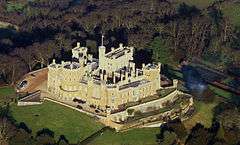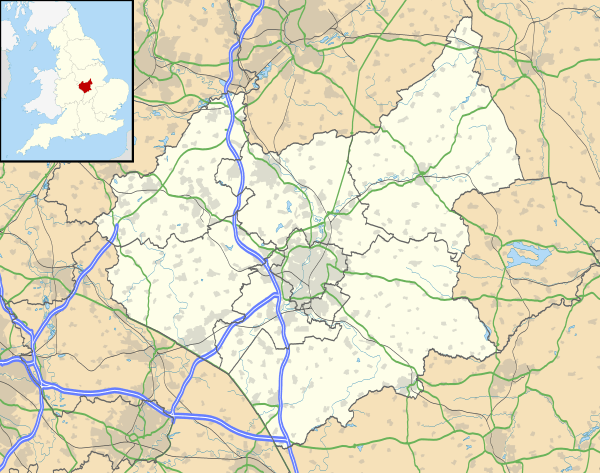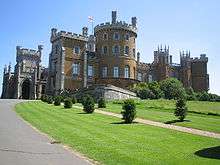Belvoir Castle
Belvoir Castle (/ˈbiːvər/ (![]()
| Belvoir Castle | |
|---|---|
 Belvoir Castle | |
 Location within Leicestershire | |
| General information | |
| Architectural style | Gothic Revival |
| Location | North East Leicestershire |
| Country | England |
| Coordinates | 52°53′40.2″N 0°46′57.22″W |
| Elevation | 138 metres (453 ft) |
| Groundbreaking | 1067 |
| Renovated | 1801–1832 |
| Owner | David Manners, 11th Duke of Rutland |
| Design and construction | |
| Architect | James Wyatt |
| Designations | |
Listed Building – Grade I | |
| Designated | 14 July 1953 |
| Reference no. | 1360870 |
The castle is near several villages, including Redmile, Woolsthorpe, Knipton, Harston, Harlaxton, Croxton Kerrial and Bottesford and the town of Grantham. Antiquarian John Leland wrote in the 16th century, "the castle stands on the very nape of a high hill, steep up each way, partly by nature, partly by the working of men's hands."[3]
History
First castle



A Norman castle originally stood on the high ground within the wapentake of Framland, overlooking the adjacent wapentake of Winnibriggs.[4] in Lincolnshire and dominating both.[5] It was built on the land of Robert de Todeni of the Doomsday Book, and inherited from him by William d'Aubigny. It then eventually passed to William's granddaughter Isabel, who married Robert de Ros circa 1234.
Belvoir was a royal manor until it was granted to Robert de Ros in 1257. He was given a licence to crenellate in 1267.[6] When the legitimate de Ros line died out in 1508, the manor and castle passed to George Manners, who inherited the castle and barony through his mother. His son was created Earl of Rutland in 1525.
Second castle
The Norman castle had been in ruins since 1464 and in 1528, Thomas Manners, 1st Earl of Rutland started construction of a new castle. It was completed in 1555.[7][8] Much of the stone for this building came from Croxton Abbey and Belvoir Priory following their dissolution.[7]:22
In the early 17th century, castle servants Joan, Margaret and Phillipa Flower were accused of murdering the 6th Earl's two young sons by witchcraft. Joan died while in prison and Margaret and Phillipa were hanged.[9]
During the English Civil War, it was one of the more notable strongholds of the king's supporters and King Charles spent a night here on his way into Lincolnshire.[7]:30
Third castle
In 1649, the castle was destroyed by Parliamentarians. A new building was started in 1654 which was designed as a large family home[7]:8 by the architect John Webb. Work was completed by 1668[7]:32 and cost £11,730 (£2.03 million today).
The 9th Earl was created Duke of Rutland in 1703. Belvoir Castle has been the home of the Manners family for five hundred years and seat of the Dukes of Rutland for over three centuries.
Fourth castle
In 1799, the 5th Duke of Rutland married Lady Elizabeth Howard. The new Duchess of Rutland soon chose architect James Wyatt to rebuild the castle in the romantic Gothic Revival style. The Duke, one of the wealthiest landholders in the United Kingdom of Great Britain and Ireland, sold seven assorted villages and their surrounding lands to fund the massive project.[10] The project was nearing completion when, on 26 October 1816, it was almost destroyed by a fire.[11] The loss - including pictures by Titian, Rubens, Van Dyck, and Reynolds - was estimated at £120,000 (£9.25 million today).
Rebuilt, again, to largely the same designs, at a cost of an additional £82,000 (£7.67 million today), the castle was largely completed by 1832. The architect Sir James Thornton[7]:50 (who was the Duke's friend and chaplain and Vicar of nearby Bottesford[12]) was chiefly responsible for this rebuilding, and the result bears a superficial resemblance to a medieval castle, its central tower reminiscent of Windsor Castle.
Whilst visiting Belvoir castle in the 1840s, Anna, Duchess of Bedford, found that the normal time for dinner was between 7:00 and 8:30 p.m. An extra meal called luncheon had been created to fill the midday gap between breakfast and dinner, but as this new meal was very light, the long afternoon with no refreshment at all left people feeling hungry. She found a light meal of tea (usually Darjeeling) and cakes or sandwiches was the perfect balance. The Duchess found taking an afternoon snack to be such a perfect refreshment that she soon began inviting her friends to join her. Afternoon tea quickly became an established and convivial repast in many middle and upper class households.[13]
The castle is open to the public and contains many works of art. The highlights of the tour are the lavish staterooms, the most famous being the Elizabeth Saloon (named after the wife of the 5th Duke), the Regents Gallery and the Roman-inspired State Dining Room.
The Queen's Royal Lancers regimental museum of the 17th and 21st Lancers was established here in 1964, but was required to leave in October 2007. The Queen's Royal Lancers and Nottinghamshire Yeomanry Museum is now at Thoresby Hall.
Estate
The castle sits in an estate of almost 15,000 acres (61 km2).[14]
Gardens

Belvoir Gardens was designed and landscaped by Elizabeth Howard, 5th Duchess of Rutland, who was married to John Manners, the 5th Duke of Rutland. It was created in 1799, the year Belvoir Castle was built. There are many unusual features to the gardens, for example the natural amphitheatre which faces the estate was formed by the moraines of glaciers and a 'root house' or summer house which survives to this day. These natural amphitheatres are now embedded with fresh water springs to ensure blooming plants throughout the year.
Belvoir Gardens was also the first site of mass spring flower bedding, a concept developed by Mr. Divers, head gardener of the gardens at the time.
The once thriving gardens are now slowly being restored to its former glory. "Friends of Belvoir Gardens" is a programme which encourages enthusiasts with green fingers to volunteer to help manage this beautifully preserved garden.
Name
The castle's name means beautiful view. In 2018, the 11th Duchess of Rutland gave a televised tour of the castle to journalist Phil Spencer, explaining how the name Belvoir is a Norman import by the French-speaking invaders of the 11th century, but the native Anglo-Saxon population was unable to pronounce such a foreign word, preferring to call it "Beaver Castle" – a usage which persists today.[10]
Mausoleum
The traditional burial place of the Manners family was St Mary the Virgin's Church, Bottesford. Since elevation to the dukedom in 1703 most Dukes have been buried in the grounds of the mausoleum at Belvoir Castle. The mausoleum at Belvoir Castle was built by The 5th Duke of Rutland, following the death of his wife, Elizabeth Howard (1780-1825), daughter of The 5th Earl of Carlisle. After its construction, most of the 18th century monuments in Belton Church were moved to the mausoleum which then became the family's main place of burial.
Burials in the mausoleum
- John Manners, 1st Duke of Rutland
- John Manners, 2nd Duke of Rutland
- John Manners, 3rd Duke of Rutland
- Charles Manners, 4th Duke of Rutland
- John Manners, 5th Duke of Rutland
- Marion Margaret Violet Lindsay Manners, Duchess of Rutland
- Charles Manners, 10th Duke of Rutland
In Literature
- Letitia Elizabeth Landon's poem

- In 2012, Catherine Bailey published a history of Belvoir Castle chronicling a mystery surrounding one of its occupants, John Manners, the 9th Duke of Rutland, which she encountered and worked to unravel while researching in the estate's archives.[15]
Present use
A corner of the castle is still used as the family home of the Manners family. Several films and television programmes have used it as a location, notably the 1980 film Little Lord Fauntleroy starring Sir Alec Guinness and Ricky Schroder. The castle itself was used as a location for The Da Vinci Code — it represented Castel Gandolfo, the Pope's summer residence. It also featured in the 1985 film Young Sherlock Holmes starring Nicholas Rowe and Alan Cox. In September 2007, it was used as a location for The Young Victoria. In the 2001 Jim Henson production of Jack and the Beanstalk: The Real Story, the castle is where the giant bones have been discovered. The kitchen scenes of Hill House were filmed here for the 1999 version of The Haunting which is a remake of the 1963 version. The castle was used as one of several stand-ins for Buckingham Palace for the 1991 comedy film King Ralph.[16]
Belvoir Castle is the host of Belvoir Fireworks,[17] an annual pyrotechnic and firework competition that takes place in mid-August. The grounds also host Belvoir Cricket Club[18] in Knipton, a village cricket club with teams playing in various leagues across Nottinghamshire. The 1st XI play in the Nottinghamshire Premier League.
In 2009, Belvoir Castle hosted the CLA Game Fair.[19] In August 2010, the castle's website was mistakenly hacked and taken over by an Algerian group who blanked the pages and inserted anti-Semitic texts in Arabic. The hackers had mistaken Belvoir Castle for Belvoir Fortress, which is located in Israel.[20]
In September 2010, the Belvoir Wassailers—the castle's own male voice choir—was reformed at the request of the Duchess. Directed by Robert-John Edwards, and accompanied on the piano by Paul Emmett, the Belvoir Wassailers performed at the castle's annual Belvoir by Candlelight celebration in December 2010. The choir is currently working on a variety of new material, including popular and folk music.
In November 2014, Emma Manners, Duchess of Rutland appointed Timothy Grayson as the castle's poet-in-residence.[21]
Briery Wood Heronry is a biological Site of Special Scientific Interest in the grounds.[22]
Belvoir Castle was used as a stand-in for Windsor Castle in the second series of British television series The Crown.[23]
See also
- List of castles in Leicestershire
- Treasure Houses of Britain, 1985 TV documentary that is, in part, on Belvoir Castle
References
- "Belvoir Castle". Collins Dictionary. n.d. Retrieved 25 September 2014.
- Historic England. "Details from listed building database (1360870)". National Heritage List for England. Retrieved 17 July 2007.
- Quoted in Cantor 1977–1978 p. 35.
- "Open Domesday Map: Woolsthorpe-by-Belvoir". Retrieved 26 October 2015.
- "Map of Framland showing Belvoir geography". Retrieved 26 October 2015.
- Cantor, Leonard (1977–1978), "The Medieval Castles of Leicestershire" (PDF), Transactions of the Leicestershire Archaeological and Historical Society, 53
- Duchess of Rutland, Rachel; Pruden, Jane. Belvoir Castle. 1000 years of Family, Art and Architecture. Frances Lincoln Ltd. p. 8. ISBN 9780711230521.
- Pevsner, Nikolaus (1984). Williamson, Elizabeth (ed.). Leicestershire and Rutland. Buildings of England. London: Penguin. p. 96. ISBN 0-14-071018-3.
- "BBC News – Witches of Belvoir 'may have been framed'". BBC. 31 October 2013. Retrieved 28 August 2014.
- "Belvoir Castle". Phil Spencer’s Stately Homes. Season 2. Episode 2. Mayfly Television Limited. 20 August 2018. BBC.
- "Fire at Belvoir Castle". Morning Post. British Newspaper Archive. 29 October 1816. Retrieved 29 July 2016 – via British Newspaper Archive.
- Pevsner, Nikolaus (1984) [1960]. Williamson, Elizabeth (ed.). Leicestershire and Rutland. Buildings of England (2nd ed.). London: Penguin. p. 97. ISBN 0-14-071018-3. (with corrections of 1992).
- p. 209, Pool, Daniel (1993) "What Jane Austen Ate and Charles Dickens Knew," Touchstone/Simon & Schuster, New York
- "The Manners Arms". The Manners Arms. Retrieved 10 August 2013.
- https://www.theguardian.com/books/2012/nov/16/the-secret-rooms-catherine-bailey-review
- "Where was King Ralph filmed?". British Film Locations. Retrieved 31 October 2017.
- "Belvoir Firework Champions – 4 amazing firework displays all on the same night!". Belvoirfireworks.co.uk. 27 August 2012. Retrieved 10 August 2013.
- "Belvoir Cricket Club, Knipton". Belvoircc.co.uk. Archived from the original on 22 July 2013. Retrieved 10 August 2013.
- Shooting Politics. "Shooting Politics, episode 1, 19th August 2009". fieldsportschannel.tv. Retrieved 31 October 2012.
- Mistaken identity for Algerian hackers
- "Leicester writer made poet-in-residence of Belvoir Castle, Leicester Mercury". Archived from the original on 23 July 2015. Retrieved 21 July 2015.
- "Designated Sites View: Briery Wood Heronry, Belvoir". Sites of Special Scientific Interest. Natural England. Retrieved 27 August 2017.
- "Netflix crews filming season two of The Crown at Belvoir Castle". Lincolnshire Reporter. Retrieved 13 March 2018.
External links
| Wikimedia Commons has media related to Belvoir Castle. |
- Official website
- Belvoir Gardens
- Belvoir Castle Contact Information
- Manners Arms
- Flickr photos tagged Belvoir Castle
- Belvoir Castle view video retrieved 18 December 2010
- Belvoir Gardens
- Map sources for Belvoir Castle
